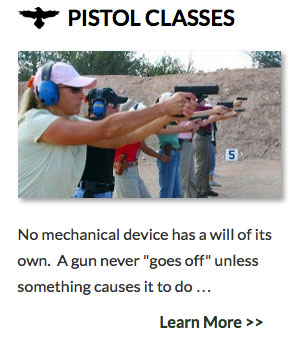Widgetized Section
Go to Admin » Appearance » Widgets » and move Gabfire Widget: Social into that MastheadOverlay zone
The Problem with Stopping Power
Continues from page 1…
.40 S&W: 155 to 165-grain jacketed hollow-point (JHP) moving at 1,100 fps or faster. All of the major manufacturers make a load like this. The United States Border Patrol has conducted extensive testing with this load using both the Federal and Remington versions in the lab and on the street with great success.
.357 SIG: 125-grain hollow-point moving at 1,350 fps. The Speer Gold Dot and Federal JHP loads are the most proven in the field. Others are available, but I do not have any hard data on them.
.45 ACP: 200 230-grain JHP. The Federal 230-grain Hydra Shok hollow-point is the most proven. The Remington 230-grain Golden Sabre hollow-point and Speer 200/230-grain Gold Dot hollow-points have also worked very well.
These trends or formulas have proved successful over and over again. Please keep in mind they are not absolutes, but they are a good bet if your agency doesn’t have the facilities or funding to extensively test potential duty ammo. I’ve seen a number of agencies change ammunition because of a single incident, which is not a good idea if the ammo has been extensively tested.
Ammunition that fails to stop an adversary is usually due to poor shot placement and not poor ammo performance. Expansion is a means to an end and not the end result. A bullet that fails to expand as shown in the gun magazines will not result in an incapacitation failure as often as a fully expanded bullet that does not hit a vital area of the body. Remember: To be effective, handgun bullets must be placed on an adversary in a vital location, and no amount of expansion or bullet diameter will change this. The best thing any law enforcement firearms instructor can do to ensure the agency-approved gun and ammo incapacitates dangerous felons is train their personnel to hit vital areas of the body while bobbing and weaving, as in a real fight. This equates to training time and ammunition, and no super-duper, thermonuclear +P+, thunder-flash, wonder hollow-point will make up for this.
Dr. Vincent DiMaio, one of the nation s foremost experts on wound ballistics, says the secret to handgun stopping power remains where you shoot your opponent and how many times you shoot them. Makes sense to me. Hardware will never make up for sound training and accurate shooting.
 Dave Spaulding is the 2010 Law Officer Trainer of the Year and Law Officer’s Firearms columnist. A 28-year law enforcement veteran who retired at the rank of lieutenant, he is the founder of Handgun Combatives. He has worked in corrections, communications, patrol, evidence collection, investigations, undercover operations, training and SWAT—and has authored more than 1,000 articles for various firearms and law enforcement periodicals. He’s also the author of the best-selling books Defensive Living and Handgun Combatives. Visit his web site at www.handguncombatives.com and like him on Facebook.
Dave Spaulding is the 2010 Law Officer Trainer of the Year and Law Officer’s Firearms columnist. A 28-year law enforcement veteran who retired at the rank of lieutenant, he is the founder of Handgun Combatives. He has worked in corrections, communications, patrol, evidence collection, investigations, undercover operations, training and SWAT—and has authored more than 1,000 articles for various firearms and law enforcement periodicals. He’s also the author of the best-selling books Defensive Living and Handgun Combatives. Visit his web site at www.handguncombatives.com and like him on Facebook.
1 2
4 Responses to The Problem with Stopping Power
You must be logged in to post a comment Login



 MidwayUSA
MidwayUSA Ruger Firearms
Ruger Firearms SCCY Firearms
SCCY Firearms Streamlight
Streamlight Action Targets
Action Targets Gunsite Academy
Gunsite Academy
Pingback: SayUncle » The problem with stopping power